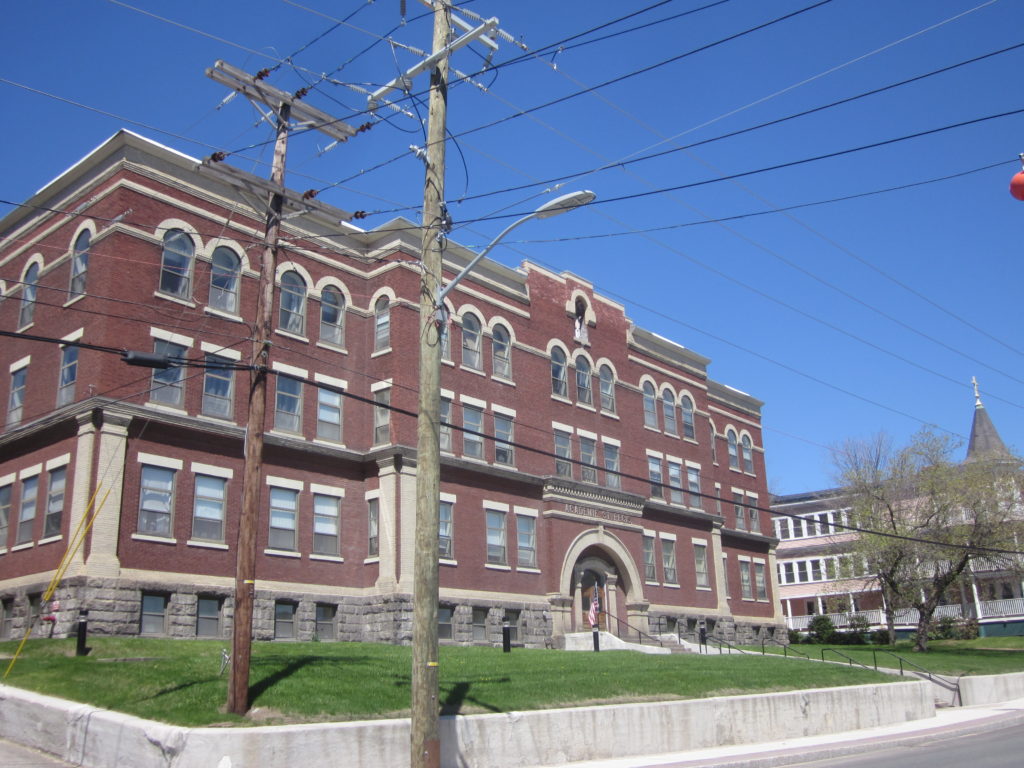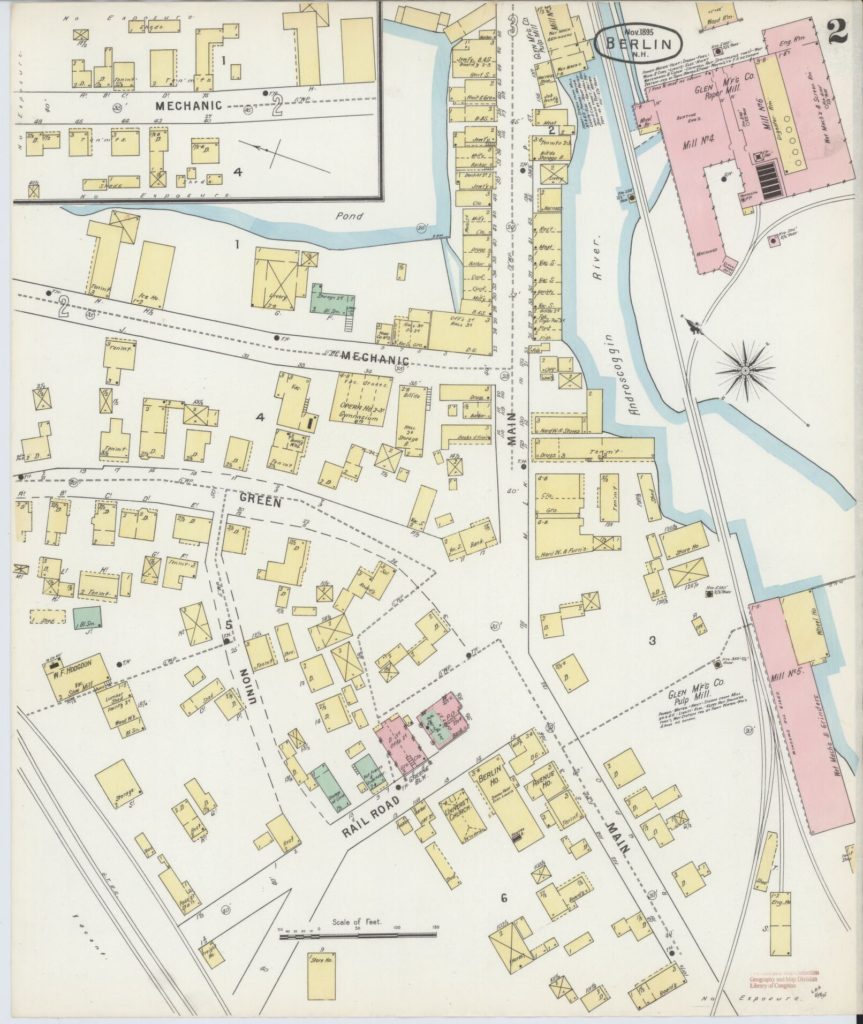See Part I here.
Among the “Little Canadas” of the U.S. Northeast, Berlin’s developed relatively late. In 1860, the town was home to little more than 400 people, only twenty of whom had been born in the Canadas. (That small number nevertheless exceeded the Irish-born.) Most of the men were either lumber workers or farm laborers, with a few also connected to the railway. A French-Canadian presence was much clearer a decade later, with some single-family households and a substantial number in boarding houses.
By 1900, 30.5 percent of Coos County inhabitants were foreign-born, and 88.5 percent of those were Canadian-born. French and English Canadians constituted the two largest immigrant groups. In fact, Coos then had the third largest French-Canadian population in absolute numbers among all counties in the state, after heavily industrialized Hillsborough and Strafford in the South.

With these French Canadians, the Catholic institution grew. By 1860, according to a late nineteenth-century source,
there were about twenty-five [Catholic] families. Father Noiseux, a priest of Lancaster, used to come visit them three or four times during the year. They held their services in a private house. Later on Berlin was attended from Gorham; first by Father Sullivan, afterwards by Fathers Charland, Gorman, and Walsh. Father Charland first agitated the question of building a church, and bought the land on which the church was erected in 1880 by Father Gorman . . . [I]n August, 1885, a resident pastor was deemed necessary, and Right Reverend D. M. Bradley [Bishop of Portland] sent Rev. N. Cournoyer to minister to them. The congregation of St. Ann’s church now numbers about 1,500 souls, the greater portion being of the French nationality.
The growing French-Canadian community could also boast two benevolent societies in 1888: a société Saint-Jean-Baptiste, presided by Oliver Lambert, and a société Saint-Joseph. And it had its own businesses, most notably the Lambert Brothers grocery store.
The Canadians quickly earned the recognition their presence merited. The town elected selectman Calixte Lambert to the state legislature in 1888. John B. Gilbert, born in Canada and naturalized in October 1888, established a reputation as a hardware and furniture dealer and became mayor at the dawn of the twentieth century—possibly the first French-Canadian mayor in New Hampshire history. (Gilbert appears to have gained citizenship just in time to vote for Lambert; one of the witnesses was in fact another Lambert.) Canadians became key players in civic administration and, within the Brown Company, many became foremen.
Further, Berlin’s first lawyer was the son of a Canadian immigrant. As told by the same local history as above,
Robert Nelson Chamberlin, son of Antoine and Electa B. (Sears) Chamberlin, was born in Bangor, N. Y., July 24, 1856. His grandfather, François Chamberlin, was born in or near Paris, France, when young emigrated to Canada, and was a marine in the British service during the War of 1812. He attained the great age of ninety-nine years, dying at the home of his son in West Stewartstown [N.H.]. Antoine Chamberlin was a native of Nicollet, P. Q. When fourteen he went to Sherbrooke, worked eight years at shoemaking, married his wife at Hinesburg, Vt., her native place, and made his home in Franklin county, N. Y., residing in Malone and Bangor until 1859, when he came to West Stewartstown where he now resides.

Robert was but three years old when his father came to Stewartstown, and, as he was one of a large family of children, and robust, he early became familiar with labor, and for years had the most meager educational advantages; from eight years of age until he was sixteen obtaining as a respite from continuous toil only a few weeks attendance at the small village school. At the latter age he had the physicial [sic] power of a well-matured man, and commanded more than the usual wages as a farm hand; but the thoughtful youth was not content to excel in this sphere. A laudable ambition prompted him to attain a higher position and a broader field of usefulness, and, as a stepping stone to this, he applied himself to the acquisition of learning. It required more than an ordinary will to force himself out from and above his associations and surroundings, and to fix his attention on an intellectual career, but his active and vigorous mind carried him on; he worked summers and devoted his winters to learning, attending the academies at Colebrook and Derby (Vt.), acquiring a good foundation for the study of law, in which he saw much to attract him, and for which he seemed well adapted.
In the winter of 1877-78 he commenced his legal education in the office of G. W. Hartshorn, at Canaan, Vt., was admitted to the bar at Guildhall in March, 1881, and formed a partnership with Mr. Hartshorn. Attracted by the life and activity of the growing town of Berlin, Mr. Chamberlin, in July of the same year, established a law office there, thus becoming the first lawyer in the place. Finding that the rules of the New Hampshire bar barred him from practice in its courts, he applied for admission, passed the rigid examination creditably, and was admitted at Concord, March 15, 1883.
He married, November 2, 1882, Maria H., daughter of Ira and Ann J. (Howard) Mason, a native of Berlin, a lady of strong New England practicality and sterling worth, in whom he has a helpmate, counselor, companion and friend. They have one child, Lafayette Ray.
Mr. Chamberlin has made rapid progress for a young lawyer, has acquired a good clientage, and is popular with the older members of the legal profession, and is entitled to much credit for what he has accomplished. He has a clear conception of the strong and the weak points of a case, is earnest and industrious in the preparation and trial of causes entrusted to him, but prefers to keep his clients out of law-suits rather than involve them in protracted litigation. He always advises a fair and honorable adjustment of difference between parties, rather than the certain expense and the uncertain results at the hands of courts and juries. The same quiet, thoughtful determination which led him to obtain, unaided, a legal education, makes the first impulse of his mind in investigating any question to search for principles rather than expedients; this inclination will tend to make him particularly strong as a counselor, and in the domain of equity practice. His briefs, pleas, and other documents are drafted to cover every point, and one of the older members of the bar says: “They may appear awkward and clumsy, and easy to be torn to pieces, but on examination we find every point covered, and every nail clinched.” Of fine physique, commanding presence, and clear voice, he has the qualities of a good advocate, and is rapidly winning his way in that difficult field. His presentation of the claims of Berlin for the establishment of the county seat, at the late county convention, won much praise from leading men, and particularly his brother lawyers.
As a citizen he heartily supports all local improvements and public enterprises calculated to advance the interests of the town and the welfare of the community; he has served as superintendent of schools, on the board of education, and is one of the selectmen of 1887. He is a member of the Congregational church, a Republican in politics, and a member of the Masonic order. Yet a young man. having scarcely attained the fullness of his physical and mental powers, Mr. Chamberlin may look forward to a long life of usefulness in his chosen profession.
Chamberlin happened to play the violin and cornet and led the local band. He served as a selectman alongside Calixte Lambert in 1887-1888. He was elected to the state legislature and for a brief time served as speaker of the House. He rose to become a justice of New Hampshire’s Superior Court.
Next week: Radicalism, industrial decline, and survivance in northern New Hampshire.

Leave a Reply